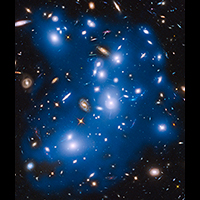
By observing the light from the orphaned stars, Hubble astronomers have assembled forensic evidence that suggests as many as six galaxies were torn to pieces inside the cluster over a stretch of 6 billion years. Computer modeling of the gravitational dynamics among galaxies in a cluster suggest that galaxies as big as our Milky Way are the likely candidates as the source of the stars. The doomed galaxies would have been pulled apart like taffy if they plunged through the center of the galaxy cluster where gravitational tidal forces are strongest. Astronomers have long hypothesized that the light from scattered stars should be detectable after such galaxies are disassembled. However, the predicted "intracluster" glow of stars is very faint and was therefore a challenge to identify.
"The Hubble data revealing the ghost light are important steps forward in understanding the evolution of galaxy clusters," said Ignacio Trujillo of the Instituto de Astrofísica de Canarias (IAC), La Laguna, Tenerife, Spain, one of the researchers involved in this study of Abell 2744. "It is also amazingly beautiful in that we found the telltale glow by utilizing Hubble's unique capabilities."
"The results are in good agreement with what has been predicted to happen inside massive galaxy clusters," added Mireia Montes of the IAC, lead author of the paper published in the Oct. 1 issue of The Astrophysical Journal.
The team estimates that the combined light of about 200 billion outcast stars contributes approximately 10 percent of the cluster's brightness.
Because these extremely faint stars are brightest at near-infrared wavelengths of light, the team emphasized that this type of observation could only be accomplished with Hubble's infrared sensitivity to extraordinarily dim light.
For a little more insight into the project see this:
http://hubblesite.org/newscenter/archive/releases/2014/43/full/
